

- #Using docker compose with docker for mac mac os x
- #Using docker compose with docker for mac install
- #Using docker compose with docker for mac drivers
If you don't, the file sharing between OS X file system and Virtual Box VM will not work. You MUST put your application directory under the /Users directory. You can always check it using docker-machine ip commandĪnd it's done - now you have a fully functional docker environment running on OS X! Easy development of Ruby on Rails apps with docker-compose NOTE: Your IP address might be different. Edit your /etc/hosts file and add this line at the very bottom: 192.168.99.100 docker While this step is not necessary, it might be easier to use an easy-to-remember name instead of an IP address. zshrc/.bashrc eval " $(docker-machine env docker-vm ) " (bonus) Edit /etc/hosts bashrc file to have the environment setup correctly in every new terminal: #. In order to make your life easier, add this line to your. Those ENV variables tell docker CLI the location of the desired host you want to operate on. λ docker-machine env docker-vmĮxport DOCKER_CERT_PATH = "/Users/teamon/.docker/machine/machines/docker-vm" export DOCKER_HOST =tcp://192.168.99.100:2376 Setting up your shellĭocker-machine comes with a handy command called env. Fortunately, we don't need to remember it. This address is required to tell the docker command line tool where the docker daemon is running. You can check the status of your new vm using: λ docker-machine lsĭocker-vm * virtualbox Running tcp://192.168.99.100:2376Īs you can see above, our new machine has an IP address 192.168.99.100. docker-machine create -d virtualbox docker-vm Invoking the following command will setup a new Virtual Box VM using boot2docker image.
#Using docker compose with docker for mac drivers
You can download the installed package from Virtual Box Downloads page Creating a new docker node inside Virtual Boxĭocker-machine virtual machine drivers are based on boot2docker.

Since we want to create a local development environment, we will use Virtual Box. λ docker -versionĭocker-machine version 0.2.0 (HEAD ) Getting Virtual Box Please pay attention to the version numbers, there is a significant chance that earlier versions of those tools won't work.
#Using docker compose with docker for mac install
brew install docker-machineĪfter installing all docker packages you should be able to access the following commands. This is a single point of management for multiple local or remote environments from one terminal. brew install docker-composeĭocker-machine allows for quick provisioning of docker-ready nodes, from local virtual machines (Virtual Box, VMWare) to cloud servers (EC2, DigitalOcean, Rackspace and more).

We will use it to define our app dependencies as well as the rails app container itself. Head over to the great documentation for more details. It removes the pain of managing separate containers for app, database and supporting services and lets you focus on your app development. Simply run brew updateĭocker-compose (fig) is a simple utility for running a set of containers defined in a YAML file. This may sound obvious, but I've spent enough time fighting with older versions of docker and docker-compose that it's worth mentioning here. This setup is using homebrew and Virtual Box, but you can install docker binaries in any way you like, as well as use VMWare instead. After struggling with boot2docker, kitematic and vagrant I finally found a setup that just works using docker-machine.
#Using docker compose with docker for mac mac os x
But then it came to my mind that this might be the perfect case for setting up a development environment using docker and docker-compose (formerly fig).ĭocker does not have native Mac OS X support yet, but there are already tools that allow running docker inside a virtual machine with the feeling of having it installed locally. With the help of homebrew this didn't sound like a challenge at all. Then we realised that we would need to setup the whole development environment on his Mac. At first it seemed trivial - just change some HTML inside a rails app. One of our designers wanted to make some changes to our job offer page.


 0 kommentar(er)
0 kommentar(er)
